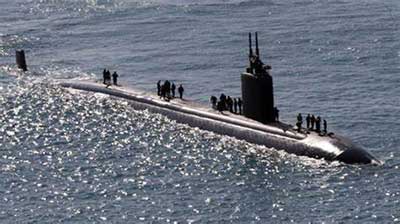Date: 18/03/2023
Relevance: GS-2: Bilateral, regional and global groupings and agreements involving India and/or affecting India’s interests.
Key Phrases: AUKUS, SSN-AUKUS, US Virginia Class Submarines, Air-Independent Propulsion, HMAS Stirling.
Context:
- Australia, the United Kingdom, and the United States announced a partnership, known as AUKUS, which will see Australia receive up to five nuclear-powered submarines to counter China's growing ambitions in the Indo-Pacific region.
Key Highlights:
- The partnership will involve the United States selling Australia three Virginia-class nuclear-powered submarines, with an option for two more, in the early 2030s.
- The partnership will also result in the trilateral development of a new submarine class, SSN-AUKUS, with the best technologies and capabilities of all three countries.
- The plan involves a phased approach which will culminate in the production and operation of SSN-AUKUS. The phases are,
- Embedded Personnel and Port Visits:
- Beginning in 2023, the Australian military and civilian personnel will embed with the US Navy, the UK Royal Navy and within the countries’ submarine industrial bases.
- This will accelerate the training and development of Australian personnel to handle nuclear-powered submarines.
- Submarine Rotational Forces:
- As early as 2027, the UK and the US plan to establish a rotational presence of one UK Astute class submarine and up to four US Virginia class submarines at HMAS Stirling near Perth, Western Australia.
- Sale of US Virginia Class Submarines:
- Beginning in the early 2030s, the US intends to sell Australia three Virginia-class submarines, with the potential to sell two more if needed.
- This will not only give Australia much-needed experience in operating nuclear-powered submarines, it will also be a stop-gap measure to shore up Australia’s ageing fleet of conventional submarines till SSN-AUKUS is inducted by the 2040s.
- SSN-AUKUS :
- With the combination of the UK’s submarine design and advanced United States technology, SSN-AUKUS will be the future attack submarine for both Australia and the UK.
- Both countries intend to build the sub in their domestic shipyards before the end of this decade with the UK expected to receive its first SSN-AUKUS in the late 2030s and Australia expected to receive the submarine in the early 2040s.
What is AUKUS?
- AUKUS is a 2021 defence deal between Australia, the UK and the US, which was struck to help Australia deploy nuclear-powered submarines in the Pacific region.
- Officially, the deal was made to emphasise upon the countries’ “shared commitment to a free-and-open Indo-Pacific region”.
- In effect, it seeks to combat China’s ambitions in the region.
- China has been an aggressive player in the South Pacific and Indian Oceans, staking territorial claims across the resource-rich region which also hosts some of the world’s busiest shipping lanes.
- China’s increasing aggression against Taiwan and in the South China Sea has been of particular note.
- While China’s territorial ambitions have elicited strong reactions from across the West, Australia, a traditional centre of influence in the Pacific, has been most directly impacted.
- Crucially, unlike Australia, China has multiple nuclear-capable submarines.
- Thus, the AUKUS partnership was signed to bolster Australia’s naval heft in the region.
How will nuclear submarines help Australia?
- Conventional diesel-engine submarines have batteries that keep and propel the vessel underwater.
- The life of these batteries can vary from a few hours to a few days.
- While newer Air-Independent Propulsion (AIP) submarines have additional fuel cells that increase the submarine’s endurance, these are used only at strategic times and can only be replenished in port.
- Both conventional and AIP subs need to come to the surface to recharge their batteries using the diesel engine.
- Nuclear-powered submarines, on the other hand, have an internal nuclear reactor, giving them near-infinite endurance to operate and stay submerged – effectively, a nuclear submarine only needs to port/surface when it is out of food and other essential supplies for the crew.
- Typically, nuclear subs are also faster than conventional submarines.
- This allows them to reach far out into the ocean and launch attacks on the enemy, an important capability for blue water navies.
- Virginia class submarines and SSN-AUKUS will give the Royal Australian Navy the capability to go into the South China Sea to protect its assets and conduct patrols, a capability which it currently does not possess.
Conclusion:
- The AUKUS partnership between Australia, the UK, and the US represents a significant move towards countering China's growing ambitions in the Indo-Pacific region.
- The phased approach of the partnership is expected to provide Australia with much-needed experience in operating nuclear-powered submarines, while also shoring up its ageing fleet of conventional submarines.
- Overall, the AUKUS partnership underscores the importance of maintaining strategic alliances in the face of evolving security challenges.
Source: The Indian Express
Mains Question:
Q. Analyze the AUKUS partnership between Australia, the UK, and the US, and discuss its potential impact on regional security dynamics in the Indo-Pacific region. (250 Words).







